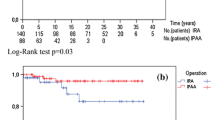Abstract
PURPOSE: The tradeoff of neoplasia control for better function represented by a stapled ileal pouch-anal anastomosis is still controversial in patients with familial adenomatous polyposis. We compared outcomes after mucosectomy and hand-sewn ileal pouch-anal anastomosis with those after stapled ileal pouch-anal anastomosis in 119 patients with familial adenomatous polyposis who underwent surgery since 1983. METHODS: Age, gender, length of follow-up, complications, quality of life, incontinence, urgency, nighttime and daytime seepage, pad usage, necessity of ileostomy, and incidence of adenomas developing in pouch and anal transitional zone were recorded. RESULTS: There were 42 mucosectomy and 77 stapled patients who were followed up for an average of 5.8 and 3.6 years, respectively, with endoscopic surveillance. There was one postoperative death in the stapled group that prohibited long-term follow-up. Nine of 42 mucosectomy patients developed pouch adenomasvs. 8 of 76 in the stapled group. Six of 42 patients developed adenomas in the mucosectomized anal transitional zone in the mucosectomy group. Twenty-one of 76 patients developed adenomas in the anal transitional zone in the stapled group. All were managed with local procedures or further surveillance. One of 76 patients developed cancer in the residual low rectum; this required further resection. Patients with stapled anastomosis had better outcomes in every category. Differences in incontinence, daytime and nighttime seepage, pad usage, and avoidance of ileostomy were statistically significant. All patients with mucosectomy required ileostomyvs. only 40 of 77 patients with stapled anastomosis. CONCLUSION: Familial adenomatous polyposis patients with stapled ileal pouch-anal anastomosis have better functional outcome and can avoid temporary diversion. This should be balanced against a 28 percent incidence of adenomas in the anal transitional zone.
Similar content being viewed by others
References
Groden J, Thliveris A, Samowitz W,et al. Identification and characterization of the familial adenomatous polyposis coli gene. Cell 1991;66:589–600.
Kinzler K, Nilbert M, Su L,et al. Identification of FAP locus genes from chromosome 5q21. Science 1991;253:661–5.
Bussey H. Familial polyposis coli: family studies, histopathology, differential diagnosis, and results of treatment. Baltimore: Johns Hopkins University Press, 1975.
Lockhart-Mummery JP. Case of complete resection of the large bowel for multiple adenomata. Proc R Soc Med 1919;12:3–45.
Tuckson WB, Lavery IC, Fazio VW, Oakley J, Church J, Milsom J. Manometric and functional comparison of ileal pouch anal anastomosis with and without anal manipulation. Am J Surg 1991;161:90–6.
Soravia C, Klein L, Berk T, O'Connor BI, Cohen Z, McLeod RS. Comparison of ileal pouch-anal anastomosis and ileorectal anastomosis in patients with familial adenomatous polyposis. Dis Colon Rectum 1999;42:1028–33.
Fazio VW, O'Riordain MG, Lavery IC,et al. Long-term functional outcome and quality of life after stapled restorative proctocolectomy. Ann Surg 1999;230:575–84.
Fazio VW, Ziv Y, Church JM,et al. Ileal pouch-anal anastomoses: complications and function in 1005 patients. Ann Surg 1995;222:120–7.
Wu JS, McGannon EA, Church JM. Incidence of neoplastic polyps in the ileal pouch of patients with familial adenomatous polyposis after restorative proctocolectomy. Dis Colon Rectum 1998;41:552–6.
Soravia C, Bapat B, Cohen Z. Familial adenomatous polyposis (FAP) and hereditary nonpolyposis colorectal cancer (HNPCC): a review of clinical, genetic and therapeutic aspects. Schweiz Med Wochenschr 1997;127:682–90.
Roth JA, Logio T. Carcinoma arising in an ileostomy stoma: an unusual complication of adenomatous polyposis coli. Cancer 1982;49:2180–4.
Beart RW Jr, Fleming CR, Banks PM. Tubulovillous adenomas in a continent ileostomy after proctocolectomy for familial polyposis. Dig Dis Sci 1982;27:553–6.
Palkar VM, de Souza LJ, Jagannath P, Naresh KN. Adenocarcinoma arising in “J” pouch after total proctocolectomy for familial polyposis coli. Indian J Cancer 1997;34:16–9.
Bassuini MM, Billings PJ. Carcinoma in an ileoanal pouch after restorative proctocolectomy for familial adenomatous polyposis. Br J Surg 1996;83:506.
Van Duijvendijk P, Vasen HF, Bertario L,et al. Cumulative risk of developing polyps or malignancy at the ileal pouch-anal anastomosis in patients with familial adenomatous polyposis. J Gastrointest Surg 1999;3:325–30.
Author information
Authors and Affiliations
About this article
Cite this article
Remzi, F.H., Church, J.M., Bast, J. et al. Mucosectomyvs. stapled ileal pouch—anal anastomosis in patients with familial adenomatous polyposis. Dis Colon Rectum 44, 1590–1596 (2001). https://doi.org/10.1007/BF02234377
Issue Date:
DOI: https://doi.org/10.1007/BF02234377




